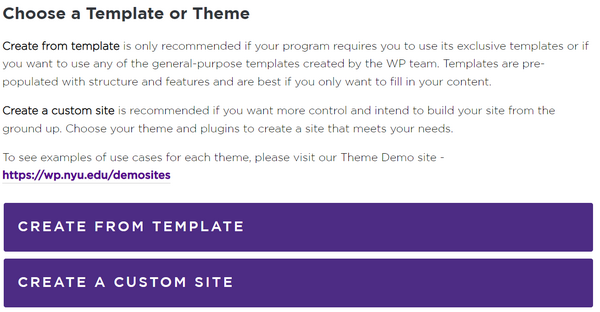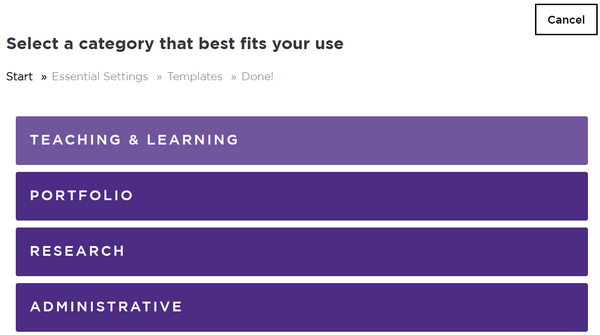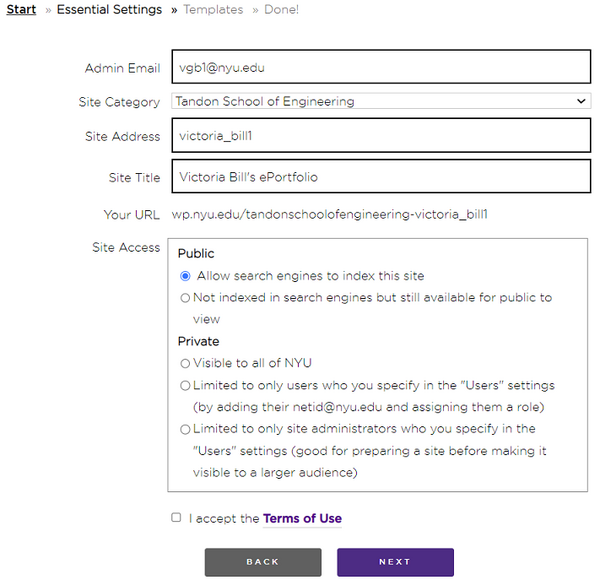Career Development
Applying to a job is a process that every student must almost always go through to gain employment. In our course, you will gain practice preparing a job package in response to a real-world job listing. Through this assignment, we hope to demystify the job application process and give you a headstart on seeking opportunities relevant to your professional interests.
The assignment will comprise four deliverables: a resume, cover letter, LinkedIn profile, and portfolio. We consider these essential elements of a successful job package.
How to Search for a Job
The first step is to identify positions that align with your interests and skills. What experience do you have to offer? What experience are you looking to gain? Take some time to read and compile job descriptions to help you answer these questions. We recommend the following resources:
On Campus Resources
- Department listings
- Campus career fairs
- Handshake
- On-campus professional society events (visible on NYU Engage)
External Resources
- Glassdoor
- Indeed
- InternQube
- Professional society conferences
Writing an Effective Resume
A resume is a one-page summary of your skills, accomplishments, and experiences. Its main purpose is to persuade a potential employer to interview you. It is important that your resume highlights the competencies you have developed through your experiences.
To develop an effective resume, you must understand the value that you and a prospective employer provide each other. Reflect on the skills, accomplishments, and experiences that you plan to give to the employer. These skills and experiences can come from your education, previous jobs, extracurricular activities, or volunteer experiences. How does it compare to the qualifications laid out in the job description? Emphasize the aspects of your experience and skills that are most relevant to the job.
Now that you have a general idea of how you’d like to market yourself, let’s organize it into a document. While the content in your resume is important, its appearance can determine if it is read. Keep your sections clear and layout simple.
Required Sections
- Contact Information: At the top of the page, list your first and last name, city and state, phone number, and NYU e-mail address. Email address should be a variation of your first and last name, preferably your personalized NYU address. You can also include links to your LinkedIn profile or portfolio.
- Education: List the name of institutions you have attended, their locations, the degree you obtained there, and your graduation date. You should also include your GPA if it is above a 3.0.
- Experience: List any paid employment, internships, volunteer work, or relevant extracurricular activities in reverse chronological order. Describe each experience by listing the name of the organization, its location, your title, and the dates you were employed there. Under each experience listed, create a bulleted list detailing your role at the organization.
- Projects: Include projects that emphasize relevant skills. Focus on your achievements – include a few bullet points that describe the project, your role, and what its results and impact were.
- Skills: Include technical and professional skills, including other languages that you may speak. Characterize your level of ability using phrases such as “familiar with,” “knowledge of,” or “experience in.”
Writing Strong Bullet Points
- An effective resume displays confidence! Begin each bullet with a strong action verb to describe the task.
- Keep the length of your bullet points to a minimum.
- Order your bullet points in order of importance to the role you are applying to.
- Keep tense consistent within a section. For example, if you’re currently working at an organization, write descriptions in present tense. For previous experiences, write the descriptions in past tense.
- Quantify or qualify: when appropriate, use numbers and context for the work you are describing.
Formatting
Keep the layout of your resume simple to allow the reader to focus on the content you’ve written. Here are a few general guidelines:
- Use single-spacing to maximize space.
- Use 1’’ - 1.5’ margins.
- Ensure that the document is no more than one-page in length.
Where to Build Your Resume
- Office offers free resume templates for Microsoft Word
- Canva has free, readymade resume templates available for you to use.
- Overleaf is a free, easy to use online LaTex editor
Further Resources
- Our recitation presentation provides helpful quick tips for preparing a resume.
- Jobscan is a website that compares your resume to the jobs you are applying to.
- The Wasserman Center Resume Guide provides more information and sample resumes.
Assignment Requirements
- Prepare a one-page resume for review.
- Upload the resume to the Submission page on the EG website.
How to Write an Effective Cover Letter
A cover letter is a one-page document that provides you an opportunity to share more about yourself and give context for the experiences listed on your resume.
Required Sections
- A header that includes contact information that matches what you provided on your resume.
- A salutation addressed to a recruiter or hiring manager; if you are unsure of who will receive your job package, you may write, “To whom it may concern.”
- Begin with a 2-3 sentence introductory paragraph that states the purpose of the letter. What position are you applying to and how did you learn about it? Start with a strong, confident statement that communicates you are a good fit for the role.
- Next, use the body of your cover letter to describe why you are the best fit for a position. Typically, bodies comprise one or two paragraphs that are 4-5 sentences in length. Here, you can introduce your experiences and education as they relate to the role. Be sure to use keywords that mirror those posted in the job posting to demonstrate your familiarity and enthusiasm for the job.
- Close the body of your cover letter with a 2-3 sentence closing paragraph that includes a call to action. How can the employer reach out to you? Repeat your contact information and mention that more details about your experience can be found in your resume.
- Lastly, sign off your cover letter with a formal closure, such as “sincerely,” “best regards,” or “respectfully.”
Further Resources
- The cover letter presentation by our Writing Consultants provides helpful quick tips for preparing a resume.
- The Tandon Career Hub provides more information and sample cover letters for your review.
Assignment Requirements
- Identify a job posting on NYU Handshake or LinkedIn.
- Prepare a cover letter in response to the job posting. The cover letter should refer to the job posting you are responding to using a link in contact using the following format:
- [Recipient Name]
- [Recipient Title]
- [Recipient Company]
- Re: Application in Response to [Your Link]
- Upload the cover letter on the EG website.
How to Create an Effective LinkedIn Profile
LinkedIn is an online professional networking platform with millions of members worldwide. Users on the platform can create profiles and connect directly with recruiters. Its use is essential to grow your career at any stage in its development. For our course, we require that you create a LinkedIn profile so that you can begin identifying opportunities early into your career. To create a profile, please follow the steps provided by the platform’s team on this webpage.
Once you have created a profile, upload the following information to complete it.
- A professional headshot. Remember that LinkedIn is a business networking service rather than a social media platform. Choose a photo with a clean background, good lighting, and a clear image of your face. The NYU Photo Bureau provides complimentary headshots to students.
- The About Me section. Write a short paragraph describing yourself as a professional. This section displays at the top of your page – use this space to summarize your skills, experience, and objectives.
The Education section. Add our institution, your major, and current year to your profile. You may also add your high school.
- The Experience section. List any paid employment, internships, volunteer work, or relevant extracurricular activities in reverse chronological order.
As you update more sections of your profile, LinkedIn will provide a rating on completeness. A high level of completeness increases the chances of someone discovering your profile, so be sure to update your LinkedIn as you do your resume.
Now that you have completed your profile, it’s time to interact! We recommend connecting with your peers and joining groups relevant to your interests. We require that you follow at least one organization. Following a page will let you see organizational news and recruitment opportunities.
Assignment Requirements
- Create a LinkedIn profile
- Add a professional headshot
- Update your about me section
- Add your education and work experiences
- Follow one organization
- Submit URL to the EG website
How to Create a ePortfolio Site
The following steps describe how to create an ePortfolio using NYU’s web publishing tool.
- To begin, access the NYU web publishing site and click create a site, or directly access through this link. You must be logged in with your Net ID.
- Explore the templates shared by the web publishing team to get a sense of how a typical WordPress site is organized.
- On the next page, there are suggested options for creating a portfolio.
- The next page asks for essential settings to create the portfolio site. Enter your NYU email and Tandon School of Engineering as the site category.
- The URL and Site Title should include your name. Select “Public” as the site access. An example is shown below. Remember that this portfolio should be used and updated throughout your time at Tandon. You will want to be able to add projects as you progress through your sophomore to senior years.
- Next, select a theme for the portfolio site.
- The final option is to select plugins. At this stage, they are not necessary, this step can be skipped. Click finish to publish your portfolio site.
- You are responsible for adding an About and Project page for the milestone 3 submission. These can be rough drafts but adding more details now will allow your recitation professor to give you feedback.
Assignment Requirements
Required for Milestone 3 Submission:
- Link to your portfolio page, which includes a draft of your About page
- The draft of the About page should include your name, picture, and link to your LinkedIn profile
Required for final submission:
- Portfolio website is fully updated and utilizes a visually appealing WordPress theme. There is no leftover draft text on the page and the portfolio is ready to share on a job application as is.
The About page must include a photo of yourself and a short paragraph about your background, education, and interests. It must also include a link to your resume (this could be with a publicly accessible Google Drive link) and your LinkedIn profile.
- The Project page must include at least 4 pictures of the final SLDP prototype (this could include 1-2 CAD models), 2 pictures of the project creation process (these can be previous prototypes or pictures of prototyping or testing), and at least a two paragraph description of the SLDP. This description should be written in full sentences. If you choose to add a list of components, sensors, or actuators in the project, those can be listed as bullet points or in a table.
- Utilize your mission statement and the technical project description from your milestones to help guide you
- Think about how you want to describe your contribution to this project to a recruiter or in a technical interview, how can you relay the technical and professional skills you developed through the project?
Sources
This documentation is created in part based on resources generated for the Experiential Learning Center website and the Design Lab @ NYU MakerSpace by Som Liengtiraphan and Molly Ritmiller.


